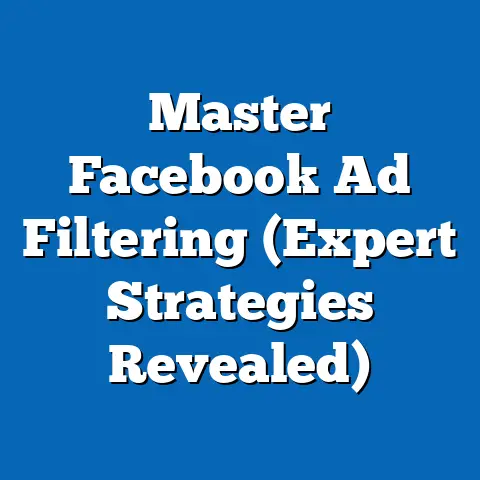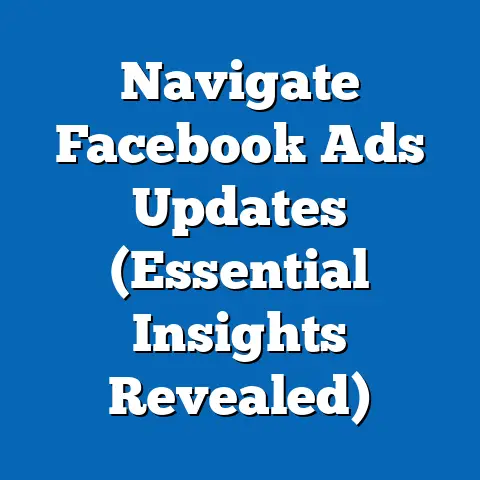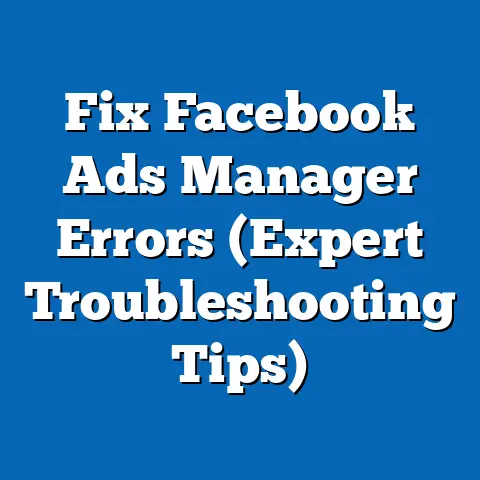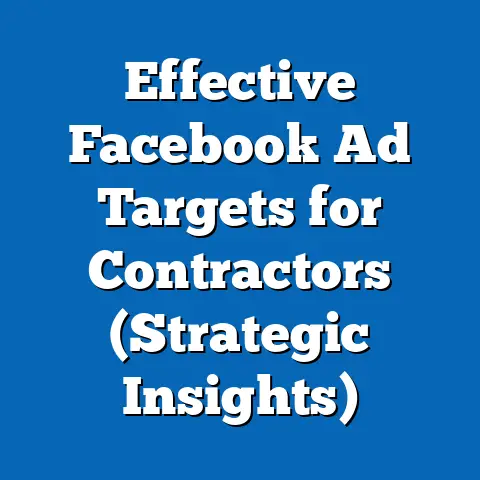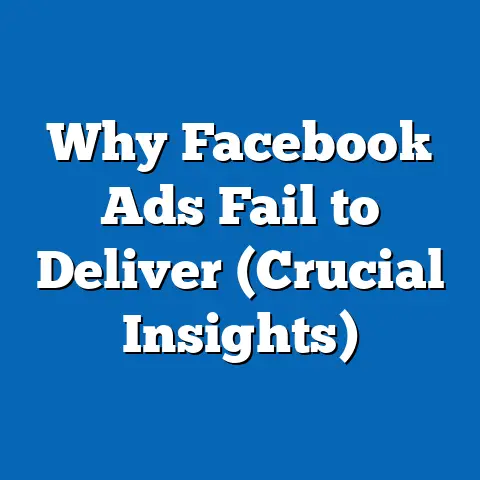Master Facebook Ads Terminology (Essential Guide)
I’ve seen countless businesses pour money into Facebook ads, hoping for a quick return, only to be left scratching their heads, wondering where their investment went. More often than not, the culprit isn’t a bad product or a poorly designed website – it’s a lack of understanding of the fundamental language of Facebook Ads. Trust me, mastering the terminology is like unlocking a secret code that leads to long-term savings and effective campaigns.
Think of it like this: you wouldn’t try to build a house without understanding the difference between a joist and a rafter. Similarly, you can’t expect to build a successful Facebook ad campaign without knowing the difference between reach and impressions, or CPC and CPM.
According to recent studies, businesses that actively monitor and optimize their Facebook ad campaigns based on key metrics see an average of 20% improvement in their ROI. That’s a significant chunk of change that you could be saving, simply by speaking the language of Facebook Ads fluently.
In this guide, I’m going to break down the essential Facebook Ads terminology you need to know, from the basic concepts to the more advanced strategies. My goal is to equip you with the knowledge to not just create ads, but to create effective ads that drive results and save you money in the long run. So, let’s dive in!
The Basics of Facebook Advertising
Facebook Ads are, at their core, paid messages that businesses use to reach a specific audience on Facebook and its affiliated platforms like Instagram, Messenger, and the Audience Network. Unlike organic posts, which are seen primarily by your existing followers, Facebook Ads allow you to target users based on a wide range of demographic, interest-based, and behavioral data.
There’s a whole buffet of ad formats to choose from, each serving a different purpose:
- Image Ads: The simplest form, featuring a single image and accompanying text. Great for visual appeal and brand awareness.
- Video Ads: Highly engaging, perfect for storytelling and demonstrating product features.
- Carousel Ads: Showcase multiple images or videos in a scrollable format, ideal for highlighting different products or features.
- Collection Ads: Designed for mobile shopping, allowing users to browse and purchase products directly from the ad.
- Lead Ads: Capture contact information from potential customers without them ever leaving Facebook.
- Instant Experience Ads: (Formerly Canvas Ads) Full-screen, mobile-optimized experiences that load instantly, offering immersive storytelling.
All of this magic happens within the Facebook Ads Manager, a comprehensive platform that allows you to create, manage, and analyze your ad campaigns. The Ads Manager is your command center, giving you complete control over your budget, targeting, creative, and performance tracking. Understanding how to navigate and utilize the Ads Manager is crucial for any successful Facebook advertiser.
Takeaway: Facebook Ads are a powerful tool for reaching a massive audience, but understanding the different ad formats and the role of the Ads Manager is the first step towards creating effective campaigns.
Key Terminology Explained
Now, let’s get down to the nitty-gritty. Here’s a breakdown of the essential Facebook Ads terms you need to know:
-
Impressions:
- Definition: An impression is counted each time your ad is displayed to a user, regardless of whether they click on it or not. It essentially represents the number of times your ad has been “seen.”
- Why it’s important: Impressions give you an idea of your ad’s visibility. A high number of impressions means your ad is being shown to a lot of people, but it doesn’t necessarily mean they’re engaging with it.
- How to interpret it: If you have a low number of impressions, your ad might not be reaching enough people. You may need to adjust your targeting or increase your budget.
- Relationship to other metrics: Impressions are closely related to reach. While reach tells you how many unique users saw your ad, impressions tell you how many times it was displayed.
- Personal Experience: I once ran a campaign with a fantastic creative but shockingly low impressions. Turns out, my budget was too low for my target audience. Increasing the daily spend significantly boosted impressions and, eventually, conversions.
-
Reach:
- Definition: Reach is the number of unique individuals who have seen your ad. Unlike impressions, reach counts each person only once, even if they’ve seen your ad multiple times.
- Why it’s important: Reach helps you understand the breadth of your audience. It tells you how many different people you’re actually reaching with your message.
- How to interpret it: A low reach might indicate that your targeting is too narrow or that your budget is insufficient to reach your desired audience.
- Relationship to other metrics: Reach and impressions work together. A high number of impressions with a low reach suggests that your ad is being shown repeatedly to the same people.
- Personal Experience: I had a campaign targeting a very specific niche. The reach was limited, but the engagement was incredibly high. This taught me that sometimes, quality over quantity is key.
-
Engagement:
- Definition: Engagement refers to any interaction a user has with your ad, such as likes, shares, comments, clicks, and saves.
- Why it’s important: Engagement indicates how interested your audience is in your ad and your brand. High engagement can lead to increased brand awareness, website traffic, and ultimately, conversions.
- How to interpret it: Low engagement might mean your ad creative isn’t resonating with your audience, or that your targeting is off.
- Relationship to other metrics: Engagement is directly related to CTR and conversion rate. Higher engagement often leads to higher click-through rates and a greater likelihood of conversions.
- Personal Experience: I once A/B tested two different ad copies. One was straightforward and informative, the other was humorous and engaging. The humorous ad received significantly more engagement, proving that personality can go a long way.
-
CTR (Click-Through Rate):
- Definition: CTR is the percentage of people who saw your ad (impressions) and clicked on it. It’s calculated as (Total Clicks / Total Impressions) x 100.
- Why it’s important: CTR is a key indicator of your ad’s relevance and appeal. A high CTR suggests that your ad is capturing attention and driving traffic to your website or landing page.
- How to interpret it: A low CTR might mean your ad creative is weak, your targeting is off, or your call-to-action isn’t compelling enough.
- Relationship to other metrics: CTR is a crucial factor in determining your quality score and ad costs. A higher CTR can lead to lower CPC and CPM.
- Personal Experience: I spent weeks optimizing a single ad image. The result? A CTR that was 3x higher than my previous best. It proved to me that visual appeal is paramount.
-
CPC (Cost Per Click) and CPM (Cost Per Mille):
- Definition:
- CPC is the amount you pay each time someone clicks on your ad.
- CPM (Cost Per Mille or Cost Per Thousand) is the amount you pay for every 1,000 impressions of your ad.
- Why they’re important: CPC and CPM are crucial for understanding your advertising costs and optimizing your budget.
- How to interpret them:
- A high CPC might indicate that your ad is not relevant enough, or that you’re bidding too aggressively.
- A high CPM might mean that your target audience is highly competitive, or that your ad quality is low.
- Relationship to other metrics: CPC and CPM are directly influenced by your quality score, targeting, and bidding strategy.
- Personal Experience: I once managed to lower my CPC by 40% simply by refining my targeting and improving my ad copy. It was a testament to the power of optimization.
- Definition:
-
Conversion Rate:
- Definition: Conversion rate is the percentage of people who clicked on your ad and then completed a desired action on your website or landing page, such as making a purchase, filling out a form, or subscribing to a newsletter.
- Why it’s important: Conversion rate is the ultimate measure of your ad campaign’s success. It tells you how effectively you’re turning ad clicks into valuable actions.
- How to interpret it: A low conversion rate might mean your landing page is poorly designed, your offer isn’t compelling enough, or your target audience isn’t a good fit for your product or service.
- Relationship to other metrics: Conversion rate is directly influenced by CTR, CPC, and the overall user experience on your website or landing page.
- Personal Experience: I once focused solely on driving traffic to my website, only to realize that my conversion rate was abysmal. I revamped my landing page with a clearer call-to-action and saw an immediate improvement.
-
Ad Set:
- Definition: An ad set is a group of ads that share the same budget, schedule, targeting, and placement settings. It’s a crucial organizational element within your Facebook ad campaign.
- Why it’s important: Ad sets allow you to test different targeting options, ad placements, and bidding strategies within the same campaign.
- How to interpret it: By comparing the performance of different ad sets, you can identify which strategies are most effective for your target audience.
- Relationship to other metrics: Ad sets are the foundation for analyzing the performance of different targeting and placement options.
- Personal Experience: I always create multiple ad sets with different targeting options to see which audience segments respond best to my ads.
-
Target Audience:
- Definition: Your target audience is the specific group of people you want to reach with your ads, based on factors like demographics, interests, behaviors, and location.
- Why it’s important: Targeting the right audience is crucial for maximizing your ad spend and achieving your campaign goals.
- How to interpret it: If your ads aren’t performing well, it might be because you’re targeting the wrong audience.
- Relationship to other metrics: Your target audience directly impacts your reach, engagement, CTR, and conversion rate.
- Personal Experience: I once mistakenly targeted the wrong age group for a product. The results were disastrous. It taught me the importance of thorough audience research.
-
Lookalike Audiences:
- Definition: Lookalike audiences are groups of people who share similar characteristics with your existing customers or website visitors. Facebook creates these audiences by analyzing the data of your source audience (e.g., customer list, website traffic) and identifying common traits.
- Why it’s important: Lookalike audiences allow you to expand your reach beyond your existing customer base and target new people who are likely to be interested in your products or services.
- How to interpret it: Lookalike audiences can be a highly effective way to find new customers, but it’s important to test different source audiences and lookalike percentages to optimize performance.
- Relationship to other metrics: Lookalike audiences can significantly improve your reach, engagement, and conversion rate.
- Personal Experience: I’ve had tremendous success using lookalike audiences based on my top-spending customers. It’s like cloning my best customers!
-
Retargeting:
- Definition: Retargeting is the practice of showing ads to people who have previously interacted with your website, app, or Facebook page.
- Why it’s important: Retargeting is highly effective because it allows you to re-engage with people who have already shown interest in your brand.
- How to interpret it: Retargeting campaigns often have higher conversion rates than other types of campaigns because you’re targeting people who are already familiar with your brand.
- Relationship to other metrics: Retargeting can significantly improve your conversion rate and ROI.
- Personal Experience: I always use retargeting to show ads to people who abandoned their shopping carts. It’s a great way to recover lost sales.
-
Ad Creative:
- Definition: Ad creative refers to the visual and textual elements of your ad, including the image or video, headline, body copy, and call-to-action.
- Why it’s important: Your ad creative is what captures people’s attention and persuades them to click on your ad.
- How to interpret it: Effective ad creative is visually appealing, relevant to your target audience, and clearly communicates your message.
- Relationship to other metrics: Your ad creative directly impacts your CTR, engagement, and conversion rate.
- Personal Experience: I once spent hours crafting the perfect ad copy, only to realize that my image was completely irrelevant. It taught me that all elements of your ad creative must work together.
-
A/B Testing:
- Definition: A/B testing (also known as split testing) is the process of comparing two versions of an ad or landing page to see which one performs better.
- Why it’s important: A/B testing allows you to optimize your ads and landing pages based on data, rather than guesswork.
- How to interpret it: By testing different headlines, images, ad copy, and calls-to-action, you can identify which elements resonate best with your audience.
- Relationship to other metrics: A/B testing can significantly improve your CTR, engagement, and conversion rate.
- Personal Experience: I’m a huge advocate of A/B testing. I constantly test different ad variations to see what works best.
-
Quality Score:
- Definition: Quality Score is a metric used by Facebook to assess the relevance and quality of your ads. It’s based on factors like your ad’s expected click-through rate, relevance to your target audience, and landing page experience.
- Why it’s important: A higher quality score can lead to lower ad costs and better ad placement.
- How to interpret it: To improve your quality score, focus on creating relevant, engaging ads that provide a positive user experience.
- Relationship to other metrics: Quality score directly impacts your CPC, CPM, and ad delivery.
- Personal Experience: I’ve seen my ad costs plummet after improving my quality score. It’s a game-changer.
Impressions:
- Definition: An impression is counted each time your ad is displayed to a user, regardless of whether they click on it or not. It essentially represents the number of times your ad has been “seen.”
- Why it’s important: Impressions give you an idea of your ad’s visibility. A high number of impressions means your ad is being shown to a lot of people, but it doesn’t necessarily mean they’re engaging with it.
- How to interpret it: If you have a low number of impressions, your ad might not be reaching enough people. You may need to adjust your targeting or increase your budget.
- Relationship to other metrics: Impressions are closely related to reach. While reach tells you how many unique users saw your ad, impressions tell you how many times it was displayed.
- Personal Experience: I once ran a campaign with a fantastic creative but shockingly low impressions. Turns out, my budget was too low for my target audience. Increasing the daily spend significantly boosted impressions and, eventually, conversions.
Reach:
- Definition: Reach is the number of unique individuals who have seen your ad. Unlike impressions, reach counts each person only once, even if they’ve seen your ad multiple times.
- Why it’s important: Reach helps you understand the breadth of your audience. It tells you how many different people you’re actually reaching with your message.
- How to interpret it: A low reach might indicate that your targeting is too narrow or that your budget is insufficient to reach your desired audience.
- Relationship to other metrics: Reach and impressions work together. A high number of impressions with a low reach suggests that your ad is being shown repeatedly to the same people.
- Personal Experience: I had a campaign targeting a very specific niche. The reach was limited, but the engagement was incredibly high. This taught me that sometimes, quality over quantity is key.
Engagement:
- Definition: Engagement refers to any interaction a user has with your ad, such as likes, shares, comments, clicks, and saves.
- Why it’s important: Engagement indicates how interested your audience is in your ad and your brand. High engagement can lead to increased brand awareness, website traffic, and ultimately, conversions.
- How to interpret it: Low engagement might mean your ad creative isn’t resonating with your audience, or that your targeting is off.
- Relationship to other metrics: Engagement is directly related to CTR and conversion rate. Higher engagement often leads to higher click-through rates and a greater likelihood of conversions.
- Personal Experience: I once A/B tested two different ad copies. One was straightforward and informative, the other was humorous and engaging. The humorous ad received significantly more engagement, proving that personality can go a long way.
CTR (Click-Through Rate):
- Definition: CTR is the percentage of people who saw your ad (impressions) and clicked on it. It’s calculated as (Total Clicks / Total Impressions) x 100.
- Why it’s important: CTR is a key indicator of your ad’s relevance and appeal. A high CTR suggests that your ad is capturing attention and driving traffic to your website or landing page.
- How to interpret it: A low CTR might mean your ad creative is weak, your targeting is off, or your call-to-action isn’t compelling enough.
- Relationship to other metrics: CTR is a crucial factor in determining your quality score and ad costs. A higher CTR can lead to lower CPC and CPM.
- Personal Experience: I spent weeks optimizing a single ad image. The result? A CTR that was 3x higher than my previous best. It proved to me that visual appeal is paramount.
CPC (Cost Per Click) and CPM (Cost Per Mille):
- Definition:
- CPC is the amount you pay each time someone clicks on your ad.
- CPM (Cost Per Mille or Cost Per Thousand) is the amount you pay for every 1,000 impressions of your ad.
- Why they’re important: CPC and CPM are crucial for understanding your advertising costs and optimizing your budget.
- How to interpret them:
- A high CPC might indicate that your ad is not relevant enough, or that you’re bidding too aggressively.
- A high CPM might mean that your target audience is highly competitive, or that your ad quality is low.
- Relationship to other metrics: CPC and CPM are directly influenced by your quality score, targeting, and bidding strategy.
- Personal Experience: I once managed to lower my CPC by 40% simply by refining my targeting and improving my ad copy. It was a testament to the power of optimization.
- CPC is the amount you pay each time someone clicks on your ad.
- CPM (Cost Per Mille or Cost Per Thousand) is the amount you pay for every 1,000 impressions of your ad.
- A high CPC might indicate that your ad is not relevant enough, or that you’re bidding too aggressively.
- A high CPM might mean that your target audience is highly competitive, or that your ad quality is low.
Conversion Rate:
- Definition: Conversion rate is the percentage of people who clicked on your ad and then completed a desired action on your website or landing page, such as making a purchase, filling out a form, or subscribing to a newsletter.
- Why it’s important: Conversion rate is the ultimate measure of your ad campaign’s success. It tells you how effectively you’re turning ad clicks into valuable actions.
- How to interpret it: A low conversion rate might mean your landing page is poorly designed, your offer isn’t compelling enough, or your target audience isn’t a good fit for your product or service.
- Relationship to other metrics: Conversion rate is directly influenced by CTR, CPC, and the overall user experience on your website or landing page.
- Personal Experience: I once focused solely on driving traffic to my website, only to realize that my conversion rate was abysmal. I revamped my landing page with a clearer call-to-action and saw an immediate improvement.
Ad Set:
- Definition: An ad set is a group of ads that share the same budget, schedule, targeting, and placement settings. It’s a crucial organizational element within your Facebook ad campaign.
- Why it’s important: Ad sets allow you to test different targeting options, ad placements, and bidding strategies within the same campaign.
- How to interpret it: By comparing the performance of different ad sets, you can identify which strategies are most effective for your target audience.
- Relationship to other metrics: Ad sets are the foundation for analyzing the performance of different targeting and placement options.
- Personal Experience: I always create multiple ad sets with different targeting options to see which audience segments respond best to my ads.
Target Audience:
- Definition: Your target audience is the specific group of people you want to reach with your ads, based on factors like demographics, interests, behaviors, and location.
- Why it’s important: Targeting the right audience is crucial for maximizing your ad spend and achieving your campaign goals.
- How to interpret it: If your ads aren’t performing well, it might be because you’re targeting the wrong audience.
- Relationship to other metrics: Your target audience directly impacts your reach, engagement, CTR, and conversion rate.
- Personal Experience: I once mistakenly targeted the wrong age group for a product. The results were disastrous. It taught me the importance of thorough audience research.
Lookalike Audiences:
- Definition: Lookalike audiences are groups of people who share similar characteristics with your existing customers or website visitors. Facebook creates these audiences by analyzing the data of your source audience (e.g., customer list, website traffic) and identifying common traits.
- Why it’s important: Lookalike audiences allow you to expand your reach beyond your existing customer base and target new people who are likely to be interested in your products or services.
- How to interpret it: Lookalike audiences can be a highly effective way to find new customers, but it’s important to test different source audiences and lookalike percentages to optimize performance.
- Relationship to other metrics: Lookalike audiences can significantly improve your reach, engagement, and conversion rate.
- Personal Experience: I’ve had tremendous success using lookalike audiences based on my top-spending customers. It’s like cloning my best customers!
Retargeting:
- Definition: Retargeting is the practice of showing ads to people who have previously interacted with your website, app, or Facebook page.
- Why it’s important: Retargeting is highly effective because it allows you to re-engage with people who have already shown interest in your brand.
- How to interpret it: Retargeting campaigns often have higher conversion rates than other types of campaigns because you’re targeting people who are already familiar with your brand.
- Relationship to other metrics: Retargeting can significantly improve your conversion rate and ROI.
- Personal Experience: I always use retargeting to show ads to people who abandoned their shopping carts. It’s a great way to recover lost sales.
Ad Creative:
- Definition: Ad creative refers to the visual and textual elements of your ad, including the image or video, headline, body copy, and call-to-action.
- Why it’s important: Your ad creative is what captures people’s attention and persuades them to click on your ad.
- How to interpret it: Effective ad creative is visually appealing, relevant to your target audience, and clearly communicates your message.
- Relationship to other metrics: Your ad creative directly impacts your CTR, engagement, and conversion rate.
- Personal Experience: I once spent hours crafting the perfect ad copy, only to realize that my image was completely irrelevant. It taught me that all elements of your ad creative must work together.
A/B Testing:
- Definition: A/B testing (also known as split testing) is the process of comparing two versions of an ad or landing page to see which one performs better.
- Why it’s important: A/B testing allows you to optimize your ads and landing pages based on data, rather than guesswork.
- How to interpret it: By testing different headlines, images, ad copy, and calls-to-action, you can identify which elements resonate best with your audience.
- Relationship to other metrics: A/B testing can significantly improve your CTR, engagement, and conversion rate.
- Personal Experience: I’m a huge advocate of A/B testing. I constantly test different ad variations to see what works best.
Quality Score:
- Definition: Quality Score is a metric used by Facebook to assess the relevance and quality of your ads. It’s based on factors like your ad’s expected click-through rate, relevance to your target audience, and landing page experience.
- Why it’s important: A higher quality score can lead to lower ad costs and better ad placement.
- How to interpret it: To improve your quality score, focus on creating relevant, engaging ads that provide a positive user experience.
- Relationship to other metrics: Quality score directly impacts your CPC, CPM, and ad delivery.
- Personal Experience: I’ve seen my ad costs plummet after improving my quality score. It’s a game-changer.
Takeaway: Understanding these key terms is crucial for interpreting your Facebook Ads performance and making informed decisions to optimize your campaigns.
Advanced Terminology and Concepts
Once you’ve mastered the basics, it’s time to delve into some more advanced concepts:
- Custom Audiences: These are audiences you create using your own data, such as customer lists, website traffic, or app activity. I find these incredibly powerful for personalized marketing. Imagine showing a specific product ad only to people who viewed that product page on your website – that’s the power of custom audiences.
- Ad Placement: Where your ad appears matters. Facebook offers various placements, including the Facebook News Feed, Instagram Feed, Audience Network, and Messenger. Testing different placements is essential because what works on Instagram might not work on Facebook. I always analyze placement performance to see where my ads are getting the best results.
- Campaign Objectives: Choosing the right campaign objective is critical. Are you looking for brand awareness, website traffic, or conversions? Facebook optimizes your ads based on your chosen objective, so selecting the right one is paramount. I’ve learned the hard way that choosing the wrong objective can lead to wasted ad spend.
- Bidding Strategies: Facebook offers different bidding strategies, including automatic and manual bidding. Automatic bidding lets Facebook optimize your bids for the best results, while manual bidding gives you more control. I often experiment with both to see which works best for my campaign goals.
- Analytics and Insights: Data is your best friend in Facebook advertising. Regularly analyzing your ad performance and gleaning insights is essential for continuous improvement. Key metrics to monitor include CTR, CPC, conversion rate, and ROI. I’ve built entire campaigns around insights I’ve gleaned from analyzing my ad data.
Takeaway: Mastering these advanced concepts will give you a significant edge in creating highly targeted and effective Facebook ad campaigns.
The Importance of Staying Updated
The digital advertising landscape, especially Facebook Ads, is in constant flux. New features, algorithms, and best practices emerge regularly. What worked six months ago might not work today. That’s why it’s essential to stay updated.
I make it a point to regularly check Facebook’s official resources, attend industry webinars, and read marketing blogs. Facebook’s own Blueprint courses are a fantastic resource for staying up-to-date on the latest features and best practices.
Staying updated isn’t just about learning new things; it’s about adapting to changes and avoiding costly mistakes. For example, a recent update to Facebook’s algorithm might require you to adjust your bidding strategy or targeting options.
Takeaway: Continuous learning and adaptation are crucial for long-term success in Facebook advertising.
Conclusion
Mastering Facebook Ads terminology is not just about knowing the definitions of different terms; it’s about understanding how those terms relate to each other and how they impact your ad performance. It’s about speaking the language of Facebook Ads fluently so that you can make informed decisions, optimize your campaigns, and ultimately achieve long-term savings.
I encourage you to use this guide as a reference point for your ongoing Facebook advertising efforts. Revisit it regularly, especially when you encounter new terms or concepts. And remember, the journey to mastering Facebook Ads is a continuous one. The more you learn, the more successful you’ll be. Now go out there and create some amazing, cost-effective Facebook ad campaigns!

